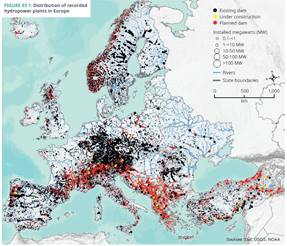Post a comment on the text below
3.2.3 Hydropower
Overview
Hydropower has a long history in Europe and currently generates around 10 % of the European net electricity (Eurostat, 2019) and more than one third of renewable electricity in EU (in 2015, based on Eurelectric & VGB Powertech (2018)). Norway and Switzerland are also countries with especially high importance of hydropower. At the same time, the construction and operation of hydropower plants causes major impacts on water bodies and adjacent wetlands, such as changes in the flow regime and sediment transport, loss of key habitats and river fragmentation.
In the second RBMPs, 22 WFD countries reported significant pressures in the form of barriers, hydrological alterations and abstractions related to hydropower production, affecting approximately 9 000 surface water bodies (6 % of total water bodies). In addition, hydropower is the most common water use for designating heavily modified water bodies, related to ca. 6 000 heavily modified water bodies in 25 WFD countries (half of these water bodies are in Norway).
In Europe, currently more than 21 000 hydropower plants exist. The majority (ca. 90 %) are hydropower plants smaller than 10 MW installed capacity (WWF, 2019). Large hydropower plants (more than 10 MW) represent only 10 % of all hydropower facilities but they generate almost 90 % of the total hydropower energy production (Devoldere et al., 2011). Germany has the highest number of hydropower plants (more than 7 700), while Austria, France, Italy, and Sweden all have more than 2 000 hydropower plants (Kampa et al., 2011). Also, in Norway and Spain, there are more than 1 000 existing hydropower plants (WWF, 2019).
Figure 9 Recorded hydropower plants in Europe


Notes: Left, Distribution of hydropower plants; Right, Distribution of hydropower plants by status and size class.
Source: WWF, 2019
The main types of hydropower plants based on the ability to store water are 1) run-of-river, 2) storage and 3) pumped storage plants. Run-of-river plants are plants without reservoirs, which run on the natural discharge of the river. Storage plants require the construction of a dam and a reservoir to store water. In many regions of Europe, run-of-river plants are the most common type of hydropower plants, but storage and pumped storage plants account for a higher share of the installed capacity.
Figure 10 Images of small hydropower plant (left) and large hydropower plants, storage and run-of-river (centre and right)
Photos not included in TalkBack
Notes: Insert notes here
Sources: 1) By Tangopaso - Own work, Public Domain, https://commons.wikimedia.org/w/index.php?curid=23481491, 2) https://vaw.ethz.ch/en/research/hydraulic-engineering/ethohydraulics.html, 3) https://upload.wikimedia.org/wikipedia/commons/f/fe/Altakraftverket%2C_Norge.jpg
The largest development of hydropower in Europe took place over the last century, harnessing most of the large hydropower potential on the continent. Nonetheless, new hydropower plants are still under development. Several hydropower plants in Europe are under construction (278) and many more are planned to be constructed (8 507). Especially, the Balkans and Turkey have ambitious plans to significantly raise their hydropower exploitation (WWF, 2019). Also, in other parts of Europe, there is an increasing number of applications for new hydropower plants, especially small ones up to 10 MW. For example, in Italy, there are more than 500 requests for new hydropower plants of 1 MW and in Scotland, there have been more than 700 applications for new hydropower development in the last 15 years (Bussettini, 2019; Fyfe, 2019).
You cannot post comments to this consultation because you are not authenticated. Please log in.


